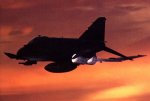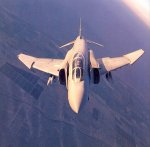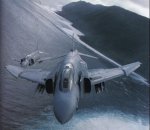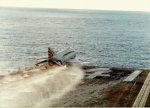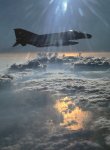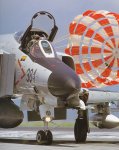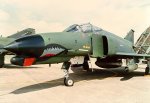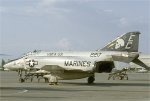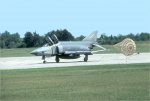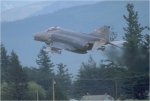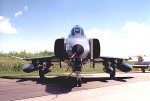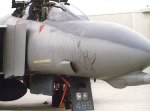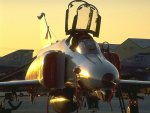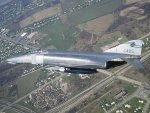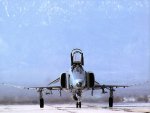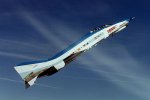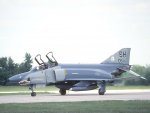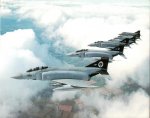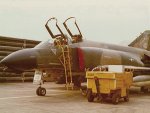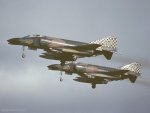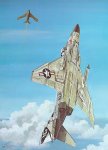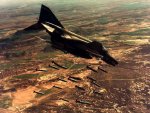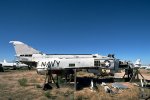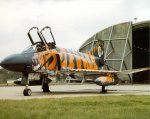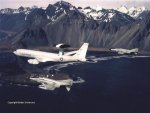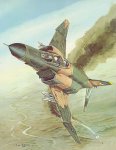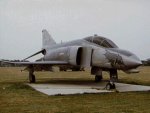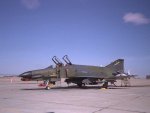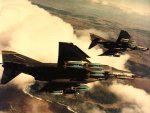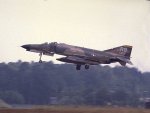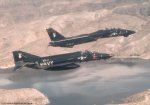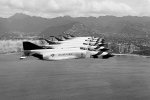- 10,865
- 762
- 113
- Location
- Appomattox, VA
I have been collecting pics of the F-4 Phantom for years, they make great wallpapers on the computer. I have been a fan of the Phantoms, or "Spooks" as some called them for years, and wanted to share some pics and information about them since I have so many .jpgs of them on my hard drive.
No post-war fighter aircraft has been produced in such numbers (5,195 to be exact) and has had such a notable impact on NATO strategic air superiority as the F-4. It was perhaps the only fighter aircraft to serve with the Air Force, Navy, and Marine Corps, and NASA as a flight test bed aircraft. It served actively from 1960, through the Vietnam War, the Cold War, Persian Gulf, before finally being retired from the F-4G Wild Weasel role in 1996. They are still serving the Armed Forces, albight as QF-4 target drones, and the few remaining in US inventory will be exhausted from this role in 2013/2014. However NASA still maintains theirs for testing, so the F-4 still flies for Uncle Sam. They also flew in formation with both the Air Force Thunderbirds and the Navy Blue Angels.
Over 560 F-4 Phantoms are still currently serving other NATO and US-friendly countries, including Egypt, Germany, Greece, Japan, South Korea and Turkey. Until very recently, Australia, Great Britain, Spain, and Israel flew the F-4. On a sadder note, our unfriendly Phantom user of Iran still uses 65 of them.
The Phantom was designed to perform in the air superiority role, as an interceptor, dogfighter, missile platform, anti-aircraft-artillery Wild Weasel role, bombing platform, reconnaissance, trainer, and target drone. It is capable of over Mach 2.2 speeds, and can carry over 9 tons of ordnance to deliver to the enemy. The Phantom is one of the most versitile fighters ever designed, and some pilots joked that the only replacement for a Phantom, is another Phantom. Indeed, Israel upgraded their F-4s in the 1990s to a performance level equivalent to the most modern jets, for a fraction of the cost of a new fighter.
The design was the oddest I can remember in recent decades, big fat body, drooping nose, wings that swung back and slightly down and then jolted up on the ends, rear elevators that flung downwards toward the ground, and the J79 jet engine almost appeared to push DOWN, not back. For the layman not accustomed to aircraft design it doesn't appear to be flyable. From Wikipedia:
The Phantom gathered a number of nicknames during its career. Some of these names included "Rhino", "Double Ugly", the "Flying Anvil", "Flying Footlocker", "Flying Brick", "Lead Sled", the "Big Iron Sled" and the "St. Louis Slugger". In recognition of its record of downing large numbers of Soviet-built MiGs, it was called the "World’s Leading Distributor of MiG Parts". As a reflection of excellent performance in spite of its bulk, the F-4 was dubbed "the triumph of thrust over aerodynamics." German Luftwaffe crews called their F-4s the Eisenschwein ("Iron Pig"), Fliegender Ziegelstein ("Flying Brick") and Luftverteidigungsdiesel ("Air Defense Diesel").
More information on the F-4 Phantom can be found here:
McDonnell Douglas F-4 Phantom II - Wikipedia, the free encyclopedia
On a final note, a very interesting piece of info showing the legacy of the F-4:
I remember during the 1980s and 1990s, there were many (especially in the Navy) who were members of the "Top Gun" generation, and were avid fans of the F-14 Tomcat, almost to the point of fanaticism over the superiority of the Tomcat over anything else in the sky. As a strong point of the ongoing legacy of the F-4 Phantom....
there are over 560 F-4 Phantoms, a design dating to 1958, still in US-friendly countries serving actively and proudly.
There are 0 F-14 Tomcats, the Navy's F-4 replacement, serving in US-friendly countries. Eat your heart out.
BIG BIG hat tip and salute to all those who were Phantom Phlyers over the past 50 years...
No post-war fighter aircraft has been produced in such numbers (5,195 to be exact) and has had such a notable impact on NATO strategic air superiority as the F-4. It was perhaps the only fighter aircraft to serve with the Air Force, Navy, and Marine Corps, and NASA as a flight test bed aircraft. It served actively from 1960, through the Vietnam War, the Cold War, Persian Gulf, before finally being retired from the F-4G Wild Weasel role in 1996. They are still serving the Armed Forces, albight as QF-4 target drones, and the few remaining in US inventory will be exhausted from this role in 2013/2014. However NASA still maintains theirs for testing, so the F-4 still flies for Uncle Sam. They also flew in formation with both the Air Force Thunderbirds and the Navy Blue Angels.
Over 560 F-4 Phantoms are still currently serving other NATO and US-friendly countries, including Egypt, Germany, Greece, Japan, South Korea and Turkey. Until very recently, Australia, Great Britain, Spain, and Israel flew the F-4. On a sadder note, our unfriendly Phantom user of Iran still uses 65 of them.
The Phantom was designed to perform in the air superiority role, as an interceptor, dogfighter, missile platform, anti-aircraft-artillery Wild Weasel role, bombing platform, reconnaissance, trainer, and target drone. It is capable of over Mach 2.2 speeds, and can carry over 9 tons of ordnance to deliver to the enemy. The Phantom is one of the most versitile fighters ever designed, and some pilots joked that the only replacement for a Phantom, is another Phantom. Indeed, Israel upgraded their F-4s in the 1990s to a performance level equivalent to the most modern jets, for a fraction of the cost of a new fighter.
The design was the oddest I can remember in recent decades, big fat body, drooping nose, wings that swung back and slightly down and then jolted up on the ends, rear elevators that flung downwards toward the ground, and the J79 jet engine almost appeared to push DOWN, not back. For the layman not accustomed to aircraft design it doesn't appear to be flyable. From Wikipedia:
The Phantom gathered a number of nicknames during its career. Some of these names included "Rhino", "Double Ugly", the "Flying Anvil", "Flying Footlocker", "Flying Brick", "Lead Sled", the "Big Iron Sled" and the "St. Louis Slugger". In recognition of its record of downing large numbers of Soviet-built MiGs, it was called the "World’s Leading Distributor of MiG Parts". As a reflection of excellent performance in spite of its bulk, the F-4 was dubbed "the triumph of thrust over aerodynamics." German Luftwaffe crews called their F-4s the Eisenschwein ("Iron Pig"), Fliegender Ziegelstein ("Flying Brick") and Luftverteidigungsdiesel ("Air Defense Diesel").
More information on the F-4 Phantom can be found here:
McDonnell Douglas F-4 Phantom II - Wikipedia, the free encyclopedia
On a final note, a very interesting piece of info showing the legacy of the F-4:
I remember during the 1980s and 1990s, there were many (especially in the Navy) who were members of the "Top Gun" generation, and were avid fans of the F-14 Tomcat, almost to the point of fanaticism over the superiority of the Tomcat over anything else in the sky. As a strong point of the ongoing legacy of the F-4 Phantom....
there are over 560 F-4 Phantoms, a design dating to 1958, still in US-friendly countries serving actively and proudly.
There are 0 F-14 Tomcats, the Navy's F-4 replacement, serving in US-friendly countries. Eat your heart out.
BIG BIG hat tip and salute to all those who were Phantom Phlyers over the past 50 years...
Attachments
-
49.9 KB Views: 58
-
49.8 KB Views: 68
-
37.2 KB Views: 54
-
68 KB Views: 64
-
49.6 KB Views: 58
-
68.1 KB Views: 61
-
37.4 KB Views: 53
-
33.6 KB Views: 59
-
60.6 KB Views: 62
-
48.7 KB Views: 61
Last edited:







